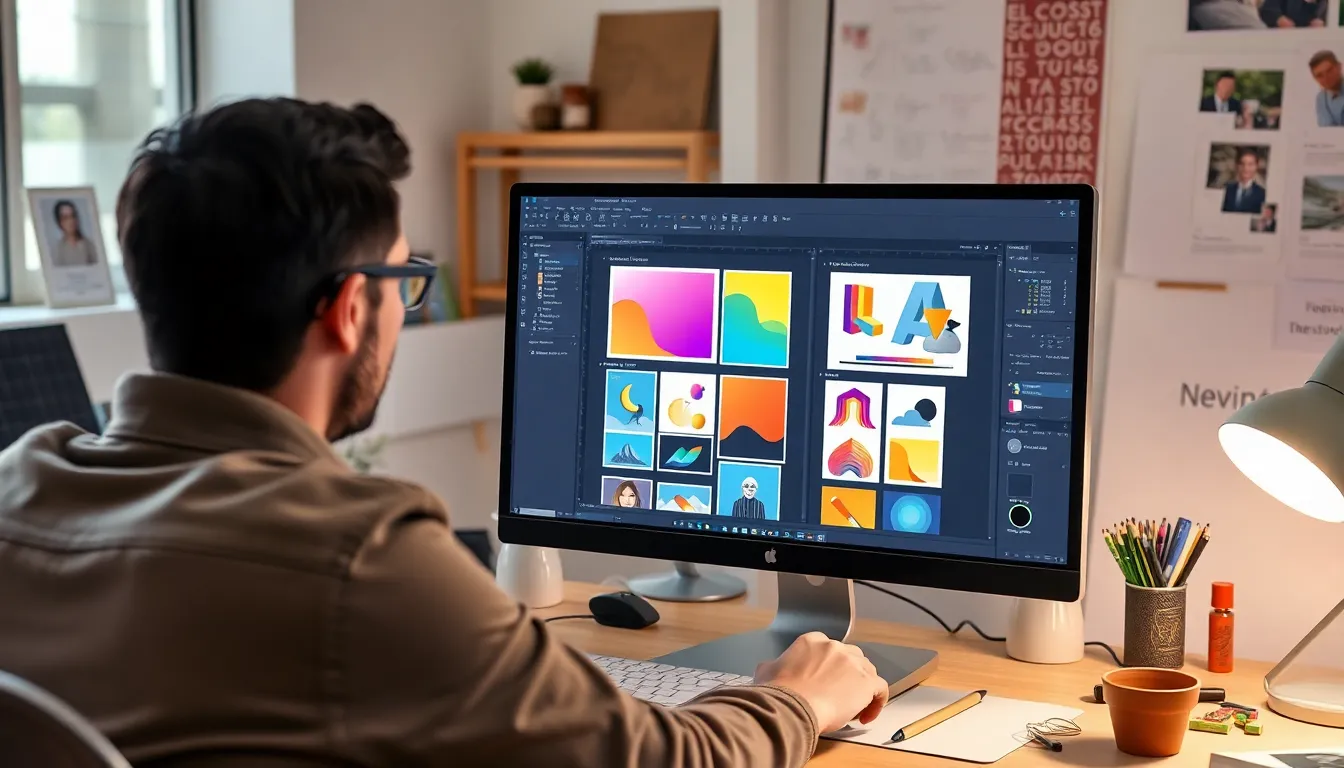Moving artboards in Illustrator might sound like a task best left to the pros, but it’s easier than finding a cat video on the internet. Whether you’re rearranging your masterpiece or just trying to avoid that awkward overlap, mastering this skill can save time and sanity.
Imagine trying to juggle a dozen artboards while simultaneously keeping your creativity flowing. It’s like trying to balance on a unicycle while juggling flaming torches—possible but not recommended. With a few simple tricks up your sleeve, you’ll be gliding through artboard adjustments like a pro. Get ready to unleash your inner design ninja and take control of your workspace.
Table of Contents
ToggleHow To Move Artboards In Illustrator
Artboards serve as essential components in Adobe Illustrator, allowing for organized workspace management. Users benefit from understanding the function and structure of artboards for better design execution.
What Are Artboards?
Artboards are defined areas within Illustrator where users create and arrange their design elements. Each artboard can represent a different design iteration or layout, accommodating various project needs. Designers can customize the size and orientation of each artboard, making them versatile tools for both print and digital projects. Users can easily add multiple artboards to a single document, streamlining workflows and improving design coordination.
Importance of Artboards in Design
Artboards play a crucial role in the design process. They enable designers to visualize multiple concepts side by side, facilitating comparison and improvements. Effective use of artboards enhances project organization, allowing for separate layouts within a single file without the need for extensive document management. Collaborations benefit from artboards as they help maintain clarity, ensuring all team members stay aligned with project objectives. Each artboard can serve as a distinct canvas, thus fostering creativity and experimentation.
Methods to Move Artboards

Moving artboards in Adobe Illustrator can streamline design processes and enhance organization. Below are effective methods for adjusting artboard positions.
Using the Artboard Tool
Users can easily move artboards by selecting the Artboard Tool from the toolbar. This tool allows designers to click and drag artboards to new locations. While dragging, artboards detach from their original positions. Aligning them with existing guides or other elements helps maintain visual balance. Holding the Shift key while moving constrains the artboard’s position to vertical or horizontal movements, enabling precise adjustments.
Adjusting Artboard Position in the Control Panel
The Control Panel offers another method for repositioning artboards. After selecting an artboard with the Artboard Tool, the Control Panel displays various position fields. Entering specific numerical values in the X and Y position boxes allows for exact placement. Inputting measurements ensures consistent distances between artboards. Designers can also change the width and height directly in this panel, adjusting design space as needed.
Tips for Effective Artboard Management
Effective artboard management enhances productivity in Adobe Illustrator. Prioritize organization and efficiency for better design outcomes.
Organizing Artboards for Projects
Organizing artboards simplifies project navigation. Assign logical names to each artboard for easy identification. Group similar designs together to maintain coherence. Use consistent sizes and orientations to streamline comparisons across designs. Utilize color coding for visual separation, promoting clarity and reducing confusion. Regularly review artboard layouts to ensure they align with project objectives. Collaboration becomes easier with well-organized artboards, as teammates quickly locate relevant designs.
Utilizing Shortcuts for Efficiency
Utilizing shortcuts saves time and enhances workflow. Master the Artboard Tool by pressing Shift + O for quick access. Moving artboards becomes straightforward with the keyboard shortcuts for specific adjustments. Use the arrow keys for fine-tuning positions, ensuring accuracy in placements. Cmd/Ctrl + N creates new artboards efficiently. Familiarity with the Control Panel streamlines resizing and repositioning processes. Integrating these shortcuts into daily practice boosts overall efficiency in design tasks.
Common Issues When Moving Artboards
Moving artboards in Illustrator can sometimes lead to complications. Users might encounter issues such as overlapping artboards, size discrepancies, or alignment problems.
Troubleshooting Artboard Overlap
Artboard overlap can hinder project clarity. To resolve this, users should first assess artboard placement. Utilizing the Artboard Tool allows for a visual overview of all artboards. If multiple artboards intersect, repositioning them using click-and-drag techniques minimizes overlap. For precise adjustments, pressing the Shift key ensures movement along a single axis. It simplifies realignment by maintaining equidistance between artboards. Checking alignment guides also aids in significant adjustments, providing a cleaner layout.
Fixing Artboard Size and Alignment Problems
Occasionally, artboards may not match in size, causing design inconsistencies. Users can adjust their sizes by selecting an artboard and modifying its dimensions in the Control Panel. Entering exact numerical values ensures uniformity across the workspace. Aligning artboards is equally important; selecting multiple artboards and using the align options streamlines alignment efforts. This feature provides ways to center artboards relative to one another. Leveraging these strategies enhances overall design coherence and improves workflow efficiency.
Conclusion
Mastering the art of moving artboards in Adobe Illustrator can significantly enhance a designer’s workflow. By utilizing the Artboard Tool and implementing organizational strategies, users can create a more efficient workspace. The ability to adjust artboards easily not only fosters creativity but also improves project organization.
Incorporating shortcuts and troubleshooting techniques can further streamline the process. With these skills, designers can navigate their projects with confidence and clarity. Embracing effective artboard management is key to unlocking greater productivity and achieving design goals.
